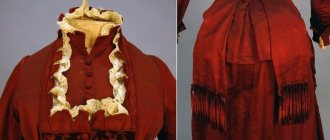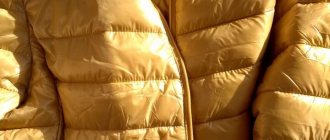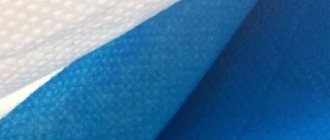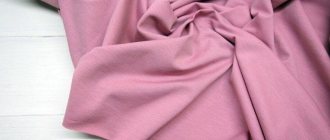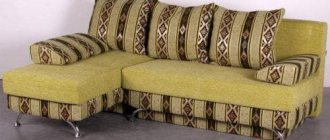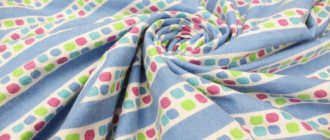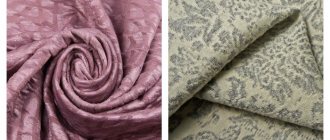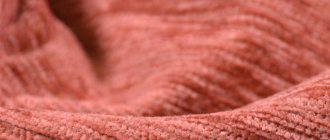Home / Synthetic fabrics
Back
Published: 01/14/2021
Reading time: 2 min
0
58
Tactel fabric is often called second cotton. Despite its synthetic origin, the material protects well from moisture, does not create a greenhouse effect, and is pleasant to the body. Depending on the fineness of the fibers, tactel can be smooth, rough, shiny or matte.
- 1 Description and history of the material
- 2 Composition and process for obtaining fibers
- 3 Types: their features and purpose
- 4 Areas of use
- 5 Care
- 6 Conclusion
Description and history of the material
Tactel is a soft, pleasant to the touch fabric. Depending on the thickness of the yarn, it can be smooth or rough.
The material was invented in 1983 by DuPont technologists. Wanting to emphasize the extraordinary softness of the fiber, the developers gave it the name tactel - from the Latin word tactus (“touch”). At the same time, the trademark of the same name was patented. It was later resold to the American company Invista.
Fact. Today, tactel is produced primarily in China at enterprises owned by this corporation.
Fabrics and care instructions
Any professional clothing, first of all, must meet the requirements of safety, durability and long-term use, especially when it comes to the medical field. For medical worker uniforms, the most important factor is the fabric from which the uniform is made.
To produce clothing, we use only those materials that meet all sanitary and hygienic requirements in accordance with the relevant GOSTs. Medical clothing is made from cotton and blended fabrics of imported and domestic production with blood- and water-repellent properties.
Each clothing model in our online store is the result of the painstaking work of designers, seamstresses, and quality control department specialists.
TC Premium
(Composition: 65% polyester, 35% cotton. Density: 120 g/m2.) – one of the most popular fabrics used for sewing summer medical gowns, suits and blousons. The quality of the material is achieved through a spinning system in which fibers of the same length and thickness are selected. Due to this, the fabric is stronger, smoother and less “fluffy”. We recommend regular washing at 40˚C or boiling washing (for white items). Products must not be chlorinated or bleached if colored finishes are used. You can iron with a warm iron at temperatures up to 150˚C.
Satori
(Composition: 50% polyester, 50% cotton. Density: 145 g/m2.) - a fabric that has won the trust of many medical institutions. Doctors can feel comfortable wearing clothes made from this fabric all day long due to the high cotton content. It is recommended to wash at a temperature of 40-60˚C; white items can be autoclaved and bleached with chlorine-containing substances. Colored and mixed (with colored edging) should be washed in water no higher than 40 degrees. Ironing temperature - no more than 150C.
Satori light
(Composition: 50% polyester, 50% cotton. Density: 115 g/m2.) – mixed fabric, ideal for light summer medical suits, blouses and dressing gowns. Functional, comfortable and tactile clothing. The washing temperature should not exceed 60 °C, and if there are colored inserts - 40 °C. Repeated bleaching and autoclaving of white products is possible. The fabric can be ironed at a temperature not exceeding 150 °C.
Stretch
(Composition: 100% polyester, weight: 180 g/m2.) - the fabric practically does not wrinkle, there is no shrinkage after washing, it retains color well. It is recommended to machine wash in a gentle (delicate) cycle at a temperature not exceeding 30˚C. The product should not be bleached with chlorine-containing substances, ironing temperature should not exceed 110°C. Do not use steam for smoothing.
Panacea
(Composition: 65% polyester, 35% viscose. Density: 160 g/m2.) - premium fabric for elegant gowns, blousons and light suits for medical workers. The fabric is pleasant to the touch, fits comfortably to the body, soft and filled. Machine wash at 60˚C is recommended. Products with heavy soiling should be dry cleaned with chlorine-containing substances; ironing temperature should not exceed 150°C. Clothes do not fade in the sun and do not fade when washed.
Torey
(Composition: 65% polyester, 35% cotton. Density: 120 g/m2.) - an ideal solution for lightweight medical clothing. Regular washing at 40-60˚C is recommended. . Colored and mixed (with colored edging) should be washed in water no higher than 40 degrees. Ironing temperature - no more than 150°C.
Satori satin
(Composition: 50% polyester, 50% cotton. Density: 190 g/m2.) – the products meet not only professional, but also aesthetic requirements. Thanks to the satin weave, the fabric has a silky texture, which gives the product an elegant, flawless look. Washing at 75˚C is recommended. Products are recommended for frequent washing. The fabric can be ironed at a temperature not exceeding 150°C. Clothing made from Satori Satin fabric ensures that characteristics are preserved during washing, bleaching and autoclaving!
Cotton 120
(Composition: 100% cotton, Weight: 120 g/m2.) Lightweight poplin weave fabric with a pattern. Thanks to the 100% cotton composition of the fabric, the clothing is highly breathable. It is comfortable and convenient. The durable, colorful print can withstand repeated autoclaving. The variety of design choices helps to create colorful products that are pleasing to the eye. This fabric is popular in the production of medical uniforms for children's departments of hospitals and clinics. The washing temperature for white items should not exceed 60°C, for colored items - no more than 40°C. Wash items separately from synthetic items, as they cause cotton to pill. Products made from this fabric must be ironed at high temperatures with damp steam.
Teredo
(Composition: 67% polyester, 33% cotton. Density: 195 g/m2.) – the fabric is light, soft and shape-resistant. Retains original size and color with frequent washing. Machine wash at 85˚C is recommended to remove stubborn stains. In white color it can be treated with chlorine-containing substances. The fabric can be ironed at a temperature not exceeding 150°C.
Medea
(Composition: 65% polyester, 35% cotton. Density: 160 g/m2.) – the fabric is light and soft, has improved strength characteristics. Thanks to the water-repellent impregnation, medical clothing keeps its shape well and is less dirty. Machine wash at 30-40˚C is recommended. The use of bleach is prohibited. The ironing temperature of products is no more than 150 ˚С.
Ayman145
(Composition: 55% cotton, 45% polyester. Density: 145 g/m2.) – the fabric meets high requirements: it has a stable dye and has high strength characteristics. Minimal shrinkage after washing. With prolonged use, it does not peel (no pills appear when worn). Washing at 40-60˚C is recommended. Products in white color can be autoclaved and bleached with chlorine-containing substances. Combined products (a combination of dark and light colors) can be machine washed at a temperature not exceeding 40°C. Ironing temperature - no more than 150˚С.
Locker
(Composition: 60% cotton, 40% polyester. Density: 150 g/m2.) – due to its composition, the fabrics are wear-resistant, last a long time and do not require special care. At the same time, the comfort, softness and breathability of cotton are preserved. Special additional treatments make the surface of the fabric even and smooth, preventing the formation of pilling. Washing at 40˚C is recommended. Ironing temperature - no more than 110°C.
Greta
(Composition: 51% cotton, 49% polyester.) – plain dyed with a water-repellent finish, thanks to which the fabric is not wetted by water and protects a person from water getting on the skin. Cotton on the reverse side provides comfort and convenience during use. The front side containing polyester provides high wear resistance and facilitates easy removal of contaminants. It is recommended to wash at a temperature of no more than 60˚C, ironing at a temperature of no more than 150˚C. Products must not be bleached with chlorine-containing substances. Production - Republic of Belarus.
Twill
(Composition: 35% cotton, 65% polyester. Density: 210 g/m2) - high-strength fabric for sewing workwear. It has a twill weave, in which the polyester thread is on the front side, and the cotton thread is on the back. This weaving has a positive effect on both the color fastness of the material and the hygienic properties of the products. Fabric with oil-repellent impregnation. Wash at a temperature of no more than 40°C with a neutral detergent. The fabric can be ironed at a temperature not exceeding 150 °C.
ADVA
(Composition: 53% cotton, 44% polyester, 3% elastane. Density: 145 g/m2) – an indispensable material for the production of sophisticated, form-fitting medical clothing. Lightness, comfort, convenience during any movement - this is the motto of this fabric. Clothes with the addition of elastane are things that: elegantly fit the body, do not wrinkle, have high breathability, and do not tend to stretch after washing. Washing at a temperature of 40-60 °C is recommended. Colored and mixed (with colored edging) should be washed in water no higher than 40 degrees. Only clothes without colored parts can be bleached. The fabric can be ironed at a temperature not exceeding 150 °C.
MILANO
(Composition: 35% cotton, 65% polyester. Average density 195 g/m2.) – fabric made in Japan. The fabric undergoes strict quality control - no shrinkage and color retention, shape-resistant, wear-resistant. We recommend regular washing at 40˚C or boiling washing (for white items). Easy removal of dirt at 85˚C. Products must not be chlorinated or bleached if colored finishes are used. You can iron with a warm iron at temperatures up to 150˚C.
Vogue
(Composition: 35% cotton, 65% polyester. Average density 145 g/m2.) – fabric made in Japan. The fabric undergoes strict quality control - wrinkle-resistant, shrink-free, shape-resistant, dyeing is durable, hygroscopic, antistatic, does not peel, and is easy to use. Fittings and components are purchased from leading European manufacturers. We recommend regular washing at 40˚C or boiling washing (for white items). Products must not be chlorinated or bleached if colored finishes are used. You can iron with a warm iron at temperatures up to 150˚C.
Weevien
(Composition: 81% cotton, 17% polyester, 2% elastane. Density: 185 g/m2) – the increased cotton content allows you to wear clothes comfortably for a long time.
Elastane improves the characteristics of the product, giving it elasticity and wrinkle resistance. Clothes with the addition of elastane are things that: elegantly fit the body, do not wrinkle, have high breathability, and do not tend to stretch after washing. Washing at 40°C is recommended. Colored and mixed (with colored edging) should be washed in water no higher than 40 degrees. Only clothes without colored parts can be bleached. Iron at an average temperature not exceeding 150˚C, with steam mode. Glossa (Composition: Composition: 65% polyester, 33% viscose, 2% spandex. Density: 160 g/m2) - differs from other medical fabrics in its softness, milky white tint and a special flowing effect, which gives the product a femininity. Washing at 30°C is recommended. Drying and spinning in a washing machine, as well as bleaching are prohibited. Iron at low temperature, not exceeding 110°C.
Composition and process of obtaining fibers
The raw material for taktel is a special type of polyamide raw material, which is obtained from petroleum products. Microfibers are ultra-thin, produced in different sections, but the largest diameter does not exceed 8 microns.
Taktel is woven from threads consisting of several fibers. The quantity varies depending on the purpose of the future textile; if necessary, it can reach up to 53 pieces. The more microfibers, the softer and stronger the yarn.
A special feature of the technology is that tactel fabric is woven with thin and thick threads, which are distributed over different surfaces of the material. The most voluminous ones run along the side in contact with the skin, and the ultra-thin ones run along the outer side. Thanks to this, moisture is quickly removed from the body, and it remains dry.
Also, the tactel does not allow external moisture to pass through, retaining it on the surface, protecting it from wind and cold air. Does not create a greenhouse effect, like other synthetic fabrics.
Other advantages of the taktel:
- 3 times stronger than cotton;
- elasticity, the ability to follow the curves of the body;
- light weight: tactel is 20-25% lighter than natural fabrics;
- resistance to bruises and pilling;
- ease of care.
Fact. Tactel dries 8 times faster than cotton.
Features and characteristics of the tactel
The Tactel trademark belongs to a division of the Du Pont concern INVISTA Inc., which specializes in the production of modern polymer fibers for various purposes. Tactel fibers get their name from the Latin root meaning “to touch” and are a polyamide-based microfiber. The category of microfibers includes fibers whose thickness does not exceed 0.7 denier (that is, the weight of such a monomer 900 m long should not exceed 0.7 g), while its surface is split into separate segments . The thickness of one tactel fiber does not exceed 8 microns, and its individual thread contains up to 52 such fibers. The threads can have different thicknesses and cross-sections, which are sometimes asymmetrical. But all modifications of tactel threads have common features, namely:
- strength (3 times stronger than cotton);
- durability;
- high softness;
- elasticity and ability to perfectly adapt to body contours;
- light weight (20% lighter than similar products made from natural raw materials);
- good air exchange ability;
- no shrinkage or creasing;
- antistatic properties;
- easy to wash, quick drying (8 times faster than cotton);
- color fastness;
- no peeling;
- variety of textures.
As a rule, when creating canvases, tactel of various thicknesses is used. The back layer facing the skin is formed by thick and soft threads, and the outer layer is formed by thinner ones. This “smart” fabric has a peculiar membrane effect. It effectively removes air and moisture from the surface of the body, while at the same time preventing wind from passing through and retaining external moisture and pollution. This avoids the thermos effect and fabric getting wet even in a warm and humid atmosphere and protects against hypothermia in bad weather. If we talk about the disadvantages, the main one is the considerable price of this high-tech material.
Types: their features and purpose
The first taktel fabric was developed for sewing sports and tourist equipment. Over time, new varieties have appeared:
| Name | Characteristic |
| Micro | Soft, stretchy fabric made from ultra-fine fibers. Ideal for wet conditions. |
| Multisoft | Made from special fiber. Textiles come in different textures, matte or glossy. Used for sewing swimsuits and lingerie. |
| Textural | Made from bulky threads. The material is dense, wear-resistant, soft. Used for sports and travel items. |
| Diablo | Fabric made from fibers of a special cross-section that reflect and refract light. The surface of the material is smooth and iridescent. |
| Aquator | Two-layer material: outer - cotton, inner (towards the body) - polyamide. Thanks to this, the synthetic fiber removes moisture to the top layer, where it quickly evaporates. |
| Climate | Thin, breathable material. Used in making clothes for hot weather. |
| Strata | It is made from threads of different diameters, which when dyed give a melange effect. |
Important. Tactel fibers combine well with synthetic and natural threads. In the manufacture of fabrics for outerwear, they are combined with cotton, wool, acrylic, and in the production of underwear - with elastane.
Types and applications
This technology is used for clothing subject to intense loads and use in harsh climates. Depending on the purpose of the product, different fabrics are produced using different types of fibers and threads and their combinations:
- Tactel® micro . A very soft fabric made from ultra-fine fiber, characterized by lightness, thinness and elasticity. It is mainly used for the production of outer knitwear. It protects well from moisture and wind and can be used in any climate, even the most humid;
- multisoft . Ultra-soft threads made from fibers of a special cross-section make it possible to produce fabrics of different textures, matte and shiny. They are used to make very comfortable and elastic swimsuits, underwear and tights;
- textural . A fabric in which heavy matte threads are woven into the warp and weft. They give the fabric special wear resistance, softness and elasticity. At the same time, the surface texture looks rough and rough. It is used to produce practical clothing for tourists and athletes (workwear);
- Tactel® Diablo . Woven from thin threads of a special cross-section, it has a smooth surface, thanks to the ability to reflect and refract light, it shimmers in different colors of the rainbow. Soft and silky to the touch, it is used to make underwear;
- aquator . Consists of two layers: the first (inner) is made of polyamide, the second (external) is made of cotton. At high humidity, polyamide fiber instantly removes moisture to the outer layer, from where it evaporates without hindrance. In sportswear made from such material, the body always remains warm and dry;
- climate . Soft fabric for comfortable, breathable clothing;
- strata . The threads of this fabric consist of fibers of different sections. When dyed, they come out in different shades and give the canvas a “melange” color.
Tactel threads can be used either alone or in combination with other natural or synthetic fibers. For the production of outerwear, they are combined with cotton, mohair, acrylic, and lycra is added to fabrics for underwear.
Sports and medical compression underwear made from tactel are very popular: leggings, socks, knee socks, stockings. It helps normalize the functioning of valves in blood vessels, speeds up the recovery period, reduces muscle pain during long-term workouts and increases endurance.
The amazingly soft and durable material is very popular all over the world. Thanks to the unique physical and hygienic properties that tactel has, it has already begun to be called “cotton of the 21st century.”
© 2021 textiletrend.ru
Areas of use
Due to its high performance properties and decorative properties, tactel is popular. The fabric is used to make:
- sportswear,
- tourist equipment: sleeping bags, backpacks;
- special suits and home clothes;
- coats, raincoats, raincoats, jackets;
- tights, stockings;
- bags, shoppers.
In addition to wardrobe items, tactel is used as furniture fabric. The material is also popular in the production of bath curtains, accessories for saunas, baths, and swimming pools.
Author:
Zakharova Nina Afanasyevna
I hope you like my article! If you find any shortcomings, just write to me about it! I am always ready for a conversation and will answer any questions you have, ask them!
